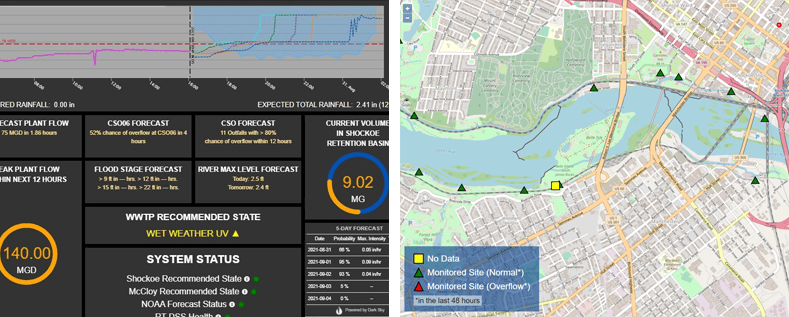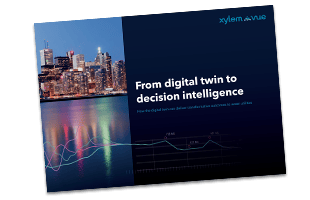Real-time digital analytics identifies more than 180 million gallons of annual CSO reduction
Department of Public Works
Richmond, Virginia
The City of Richmond turns to Xylem Vue powered by GoAigua's SSO/CSO Prediction and Prevention solution to identify critical CSO-reducing projects, putting them on a path to regulatory compliance while avoiding costly and unnecessary infrastructure.
For decades, the City of Richmond’s Department of Public Utilities has been working to reduce combined sewer overflows (CSOs) and improve water quality in the James River. Despite making significant improvements, the City still experiences between one and three billion gallons of annual overflow and is actively working to reach Department of Environmental Quality (DEQ) water quality goals. This lingering challenge, combined with an increasing number of severe weather events, has led Richmond to seek out innovative and cost-effective technologies to help deliver sewer performance improvements.
Challenge
In 2020, as part of an effort to reduce pollution in the James River, the Virginia General Assembly mandated CSO reductions necessary to meet water quality standards by 2035. The General Assembly required the creation of an Interim Plan — short-term projects which could be started within one year of the Plan’s submission, be completed by July 1, 2027, and would result in quantifiable, positive improvement to both operational costs and overall water quality — and a Final Plan to be completed by 2024.
Richmond had historically relied on a static hydraulic model to identify system overflows. This method often has limited accuracy because it does not consider critical factors that can impact the wastewater system, such as population shifts, rainfall disparity across the city, and system upgrades. The City began addressing these limitations in 2018 when it partnered with Xylem to install a series of real-time sensors across the network and increase visibility to its combined sewer system.
Now in need of a partner with the technology and expertise to help them analyze its data, provide actionable insights and make justifiable project recommendations, Richmond turned to Xylem once again.
Download case study
Solution
Harnessing the expertise of Xylem’s hydroinformatics engineering team, the City utilized Xylem Vue powered by GoAigua's SSO/CSO Prediction and Prevention applications, a real-time visualization and decision support system, and part of the Xylem Vue digital portfolio. By combining engineering, data and decision science, and industry-leading water expertise, Xylem would identify and evaluate sustainable, efficient, and cost-effective projects to help solve Richmond’s CSO challenges.
Data were initially aggregated from 34 sensors (this has since grown to 99 for improved granularity) within the system – including flow meters, level sensors, and rain gauges – with Xylem working alongside utility staff to guide the analysis and provide a clearer understanding of how the system was operating. Xylem’s solution allowed the utility to combine these data into a centralized, user-friendly interface to clearly visualize the operations of its network.
“We have been very impressed with Xylem, not only their understanding of the technology but their team’s responsiveness and collaborative approach.”
Pat Bradley, Deputy Director, City of Richmond Department of Public Utilities
At the same time, Xylem’s hydroinformatics engineering team reviewed network data from historical storms to determine which assets could be upgraded to further increase capture.
Outcome
Richmond is now measuring the real-time response of its system with current weather conditions as well as identifying when an overflow occurred and how much volume was discharged. These collected data are also used to support updates to the City’s existing hydrologic and hydraulic (H&H) model and improve its level of accuracy.
Utilizing these data, Xylem developed a list of 18 potential projects which would reduce CSO overflow across the City. Xylem then performed advanced modeling work, running simulations for each project to determine which would have the largest impact. These results were combined with cost evaluations and additional project-specific community, environmental, and operational benefits, to narrow down the initial list to a final group of 10 projects which were included in the City’s Interim Plan to meet the requirements of the legislation.

Left image: This Xylem Wastewater Network Optimization dashboard predicts flow to the plant over the next 12 hours and offers the City of Richmond guidance around whether or not to use a Wet Weather UV system.
Right image: The public-facing online map developed by Xylem and recently released by the City of Richmond provides those looking to use the James River with up-to-date information regarding recent CSO activity.
The projects identified by SSO/CSO Prediction and Prevention are expected to reduce approximately 182 million gallons of annual CSO volume with an average mitigation cost of only $0.18 per gallon – more than a 200% decrease from previous CSO reduction projects.
The City is also leveraging the solution to provide new levels of transparency to its customers and the community. Xylem developed a publicly accessible online map powered by the system’s real-time data which shows when and where CSOs are happening. This intelligence helps residents stay alert to areas of the river that have experienced overflows and provides the City critical information about how rainfall impacts different sections of their network so they can manage it more effectively.
Together with Xylem, Richmond established real-time network visibility across their sewer system to predict flows, optimize capacity, and enable intelligent data-driven decision making more accurately. With an actionable and defensible plan in place, the City avoided costly and unnecessary new infrastructure and is now on the path to regulatory compliance and achieving transformative outcomes for both the utility and the community it serves.
Let’s see what’s possible for water.
Learn more about Xylem Vue powered by GoAigua's SSO/CSO Prediction and Prevention

Learn more about Xylem Vue powered by GoAigua's smart, end-to-end wastewater system that helps utilities optimize networks and operations at significantly lower costs.
Read Digital Twin eBook

When digital twins are coupled with advanced data science like hydroinformatics and water system expertise, utilities are empowered with the intelligence they need to make crucial decisions, earlier. Discover the steps water managers can take to adopt and maximize a digital twin, today.
Webinar: The Dreaded Data Deluge - Managing Data And Information To Drive Better Outcomes

Hear how to better manage your data so you can deliver better outcomes for your utility and community.
Take the next step to optimizing your wastewater networks
Start analyzing your wastewater networks to improve operational efficiency and reduce costs.
Learn more about Xylem Vue
Learn how Xylem Vue is redefining what's possible for water with digital solutions that empower utilities to deliver transformative outcomes to their communities.

